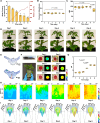Chromatic covalent organic frameworks enabling in-vivo chemical tomography
- PMID: 39468049
- PMCID: PMC11519549
- DOI: 10.1038/s41467-024-53532-7
Chromatic covalent organic frameworks enabling in-vivo chemical tomography
Abstract
Covalent organic frameworks designed as chromatic sensors offer opportunities to probe biological interfaces, particularly when combined with biocompatible matrices. Particularly compelling is the prospect of chemical tomography - or the 3D spatial mapping of chemical detail within the complex environment of living systems. Herein, we demonstrate a chromic Covalent Organic Framework (COF) integrated within silk fibroin (SF) microneedles that probe plant vasculature, sense the alkalization of vascular fluid as a biomarker for drought stress, and provide a 3D in-vivo mapping of chemical gradients using smartphone technology. A series of Schiff base COFs with tunable pKa ranging from 5.6 to 7.6 enable conical, optically transparent SF microneedles with COF coatings of 120 to 950 nm to probe vascular fluid and the surrounding tissues of tobacco and tomato plants. The conical design allows for 3D mapping of the chemical environment (such as pH) at standoff distances from the plant, enabling in-vivo chemical tomography. Chromatic COF sensors of this type will enable multidimensional chemical mapping of previously inaccessible and complex environments.
© 2024. The Author(s).
Conflict of interest statement
The authors declare no competing interests.
Figures





Similar articles
-
Ratiometric Fluorescent pH Sensor Based on a Tunable Multivariate Covalent Organic Framework.Anal Chem. 2022 Aug 9;94(31):11062-11069. doi: 10.1021/acs.analchem.2c01999. Epub 2022 Jul 26. Anal Chem. 2022. PMID: 35880804
-
Advances in Covalent Organic Frameworks as Fluorescent Sensors for pH.Luminescence. 2025 Mar;40(3):e70153. doi: 10.1002/bio.70153. Luminescence. 2025. PMID: 40119680 Review.
-
[Preparation of molecularly imprinted polymers based on covalent organic frameworks and their application to selective recognition of trace norfloxacin in milk].Se Pu. 2022 Jan;40(1):1-9. doi: 10.3724/SP.J.1123.2021.03013. Se Pu. 2022. PMID: 34985210 Free PMC article. Chinese.
-
Three-dimensional Salphen-based Covalent-Organic Frameworks as Catalytic Antioxidants.J Am Chem Soc. 2019 Feb 20;141(7):2920-2924. doi: 10.1021/jacs.9b00485. Epub 2019 Feb 7. J Am Chem Soc. 2019. PMID: 30717592
-
Recent Advances in Nanozyme Sensors Based on Metal-Organic Frameworks and Covalent-Organic Frameworks.Biosensors (Basel). 2024 Oct 23;14(11):520. doi: 10.3390/bios14110520. Biosensors (Basel). 2024. PMID: 39589979 Free PMC article. Review.
Cited by
-
Donor-acceptor type covalent organic frameworks: design, optimization strategies and applications.Chem Sci. 2025 Jun 24;16(28):12768-12803. doi: 10.1039/d5sc01267h. eCollection 2025 Jul 16. Chem Sci. 2025. PMID: 40620347 Free PMC article. Review.
-
Nanofabrication of silk microneedles for high-throughput micronutrient delivery and continuous sap monitoring in plants.Nat Nanotechnol. 2025 Aug;20(8):1142-1151. doi: 10.1038/s41565-025-01923-2. Epub 2025 Apr 29. Nat Nanotechnol. 2025. PMID: 40301677
-
Machine learning-powered activatable NIR-II fluorescent nanosensor for in vivo monitoring of plant stress responses.Nat Commun. 2025 Jun 2;16(1):5114. doi: 10.1038/s41467-025-60182-w. Nat Commun. 2025. PMID: 40456715 Free PMC article.
References
-
- Cote, A. P. et al. Porous, crystalline, covalent organic frameworks. Science310, 1166–1170 (2005). - PubMed
-
- Feng, X., Ding, X. & Jiang, D. Covalent organic frameworks. Chem. Soc. Rev.41, 6010–6022 (2012). - PubMed
-
- Ding, S.-Y. & Wang, W. Covalent organic frameworks (COFs): from design to applications. Chem. Soc. Rev.42, 548–568 (2013). - PubMed
-
- Guan, X. et al. Chemically stable polyarylether-based covalent organic frameworks. Nat. Chem.11, 587–594 (2019). - PubMed
-
- Wang, S. et al. Single-crystal 2D covalent organic frameworks for plant biotechnology. J. Am. Chem. Soc.145, 12155–12163 (2023). - PubMed
Publication types
MeSH terms
Substances
LinkOut - more resources
Full Text Sources

